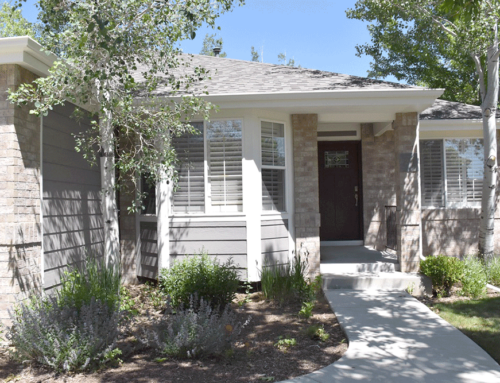Coming from the east coast (Fairfield, CT and Westchester, NY counties) I thought it would be less expensive to build in the Boulder/Front Range area. Well, I was wrong. If anything, the high demand for builders, carpenters, plumbers, and electricians makes their pricing expensive. It is a seller’s market. “Fairtrade” value seems to have little meaning here … even getting an accurate bid from a qualified General Contractor can be difficult.
All my design clients have budgets
These budgets are often inadequate for their dreamed-of projects. It makes me, as a designer, think long and hard about how to build high-quality, efficient structures that are good values as well.
Here are some of my thoughts on the subject:
Don’t design what you can’t afford
Write your “Wish List” – then get pricing early on, in the concept phase. Downscale expectations if you need to. This is not as painful as it sounds. A good design and a realistic approach can achieve significant results.
Order your goals so fundamental needs come first
Later, down the line, the “other bathroom” can get done as a smaller manageable project. Even with unlimited money, many clients stage the work to fall into their personal schedules. I have often been asked, “We will be away from date to date. Can we get the dirty work done then?”
Do the work yourself
Sometimes hidden talents emerge in homeowner-built projects. Even doing all the rough labor can save lots of cash.
True story: I had a wonderful client who was a professional choreographer. Pete grew up in a family of masons and was put to work as a laborer from an early age. He knew he wasn’t a carpenter so he hired us to do that. He did the demo, moving materials, digging, clean up, insulation, screwing the dry wall. He was right-on in his attitude. This was a wonderful, respectful collaboration that yielded cost savings for both of us.
Good design offers cost-saving components
There is no substitute for good design. In many ways, it is more important than the actual construction. Well-orchestrated project organization is key! Get the plan right. Then find quality economic components.
For example, the Marvin Window Company has an economy line that is very high quality. These products have many of the same features as the full price line. For 30% less! Choose a good manufacturer and buy their simpler, more common products. Do you really want a dual flush one-piece toilet? The Kohler Company, another favorite of mine, produces toilets that can range from $200 to $2000 dollars. You get the point. In bathrooms, the layout is key, then the fixtures, and tile.
Recycling
This one is a little tricky. Early in my career clients would go to “the house wrecker.” They’d bring back old hardware, lighting, doors, mantle pieces – all sorts of stuff – to be installed in their homes. I learned that “the old Victorian door” presents some problems. Covered with five coats of paint, it would need to be cut and fitted, stripped, sanded, holes and dings plugged, hinges replaced. Or the light fixture of “solid brass” that needed stripping, polishing, and refinishing. Don’t get me wrong, I love the antiques! But these pieces require a lot of work and probably are not cost-efficient.
On the other hand, there is a ton of remodeling being done on almost new or relatively new houses. Window changes, door and hardware upgrades, kitchen remodeling, etc., can lead to great finds.
Generally, it is not cost-effective to design around salvaged materials … Sure, some doors and windows, a bathroom vanity, or a piece of marble can be made to fit and add character. Hopefully, they were cheap. The tradeoff is carpenter time.
True story. One of my clients purchased a massive amount of cabinetry from a recycling resource shop. “I thought it was too good a deal to pass up.” The problem was it didn’t really fit anywhere – not the bathroom, nor the kitchen. “The finish is not right, can’t we paint them?” Oh boy. To this day, she is living with mismatched cabinets and pieced-together granite counters. Hardly her dream kitchen. Get the designer or carpenter to look over a purchase like this. If it works great! If not, walk away.
Salvage
So, where does salvage fit in your efficient, cost-effective model? Just today, looking at my next project (a garage that will be torn down and replaced by a new one) we wondered if the framing could be useful. Reusing the framing material would require careful dismantling and nail removal, stockpiling and covering, and forethought as to what the material can be used for.
Labor is everything in construction
All bidding/pricing is based on labor. No modern carpenter wants to use salvaged material. They prefer a fresh, sized, bundle of studs, pre-cut to wall height. It’s easier and faster.
Some change of attitude will need to happen to change this predominant mindset. The future requires a combination of re-valuing and outside-the-box thinking.
When natural resources are tapped…
Imagine this. The old front porch has walls and ceiling covered in pine, probably unfinished and aged on the backside. Will this 1000 feet of knotty pine be carefully deconstructed and ripped to be reused as the casing and baseboard of a new addition? Wood is a precious commodity. The numbers don’t lie. One thousand feet at 1.60/ft is $1600 dollars! Plus the sweat equity.
And this is important: Don’t build more than you need – it all comes down to cost per square foot.







